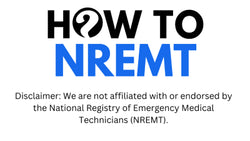Preparing for the NREMT exam can feel overwhelming, especially when you balance study time with school, work, or EMS shifts. Many students make the mistake of thinking that only long study marathons will get them ready. In reality, research shows that short, focused sessions, what we call microlearning, are often more effective for knowledge retention and exam performance.
In this guide, we’ll break down how 15-minute daily drills can improve your NREMT exam score, why this method works with your brain’s memory systems, and which strategies you can start using today.
1. Why Microlearning Works for EMS Students
Microlearning is the practice of studying small, digestible chunks of information in short bursts, typically between 10 and 20 minutes. Instead of trying to memorize hundreds of details at once, you focus on a narrow topic or skill.
For EMS students preparing for the NREMT, this approach is powerful for several reasons:
1. It Counters the Forgetting Curve
Hermann Ebbinghaus’s “forgetting curve” research shows that people lose up to 70% of new information within 24 hours if they don’t review it. Microlearning combats this by encouraging frequent, spaced repetition, moving key knowledge from short-term memory into long-term storage.
2. It Increases Engagement
Long study sessions often lead to burnout, especially after a full day of classes or clinical work. Short drills feel more manageable, so students are more likely to stick with them. Over time, consistency beats intensity.
3. It Fits into EMS Schedules
EMS students rarely have free afternoons to sit down for four hours of studying. A 15-minute drill can fit into a lunch break, commute, or downtime between shifts. That flexibility removes the “I don’t have time” excuse.
4. It Mirrors the NREMT Exam Format
The NREMT’s Computer Adaptive Testing (CAT) algorithm challenges you with one question at a time, adjusting difficulty based on your answers. Microlearning works the same way; you tackle one small concept or skill, then adapt based on performance. Practicing in this style gets your brain comfortable with the test’s structure.
2. Benefits of Microlearning for NREMT Prep

Let’s connect the science with real exam outcomes. Here’s how microlearning directly helps you improve your NREMT score:
·Improved Retention: Repeatedly reviewing vital signs, medications, or assessment steps in 15-minute chunks cements them far more effectively than cramming.
·Stronger Clinical Reasoning: Micro-scenarios encourage you to think like a provider, not just memorize facts.
·Increased Confidence: Short, successful study sessions reduce test anxiety and build momentum.
·Adaptability: Drills can focus on weak areas (airway skills, cardiology, or trauma), making your prep more personalized.
3. Five Types of 15-Minute Daily Drills
Here are proven microlearning strategies tailored for EMS students:
1. Video and Audio Refreshers + Quick Quiz
·How It Works: Watch a 3–7 minute video on a high-yield topic such as cardiac arrest protocols or listen to an audio clip on pharmacology while commuting.
·Follow-Up: End with a 5-question quiz to apply what you just learned.
·Why It Helps: Combines passive learning (watching/listening) with active recall (quizzing), boosting retention.
2. Flashcards + Mini-Quiz
·How It Works: Use flashcard apps to drill terms like medication side effects, vital sign ranges, or assessment mnemonics.
·Follow-Up: Wrap up with a 3–5 question quiz on the same content.
·Why It Helps: Flashcards are ideal for fact-based learning, while quizzes test your ability to apply them.
3. “Fact of the Day” + Scenario Practice
·How It Works: Choose one fact, like “normal infant respiratory rate is 30–60 breaths per minute.”
·Follow-Up: Create a mini scenario, such as an infant presenting with 22 respirations per minute, and ask yourself what interventions are appropriate.
·Why It Helps: Builds the bridge from memorization to clinical reasoning.
4. TEI (Technology Enhanced Item) Speed Drills
·How It Works: Spend 15 minutes practicing drag-and-drop, hotspot, or checkbox-style questions, since these are now part of the NREMT exam.
·Why It Helps: Reduces the hesitation that comes with unfamiliar formats, so you don’t waste time on test day.
5. Scenario-Based Question Blocks
·How It Works: Complete 5–6 short scenario-based questions, such as trauma cases or chest pain presentations.
·Why It Helps: These mirror real NREMT questions that emphasize judgment and decision-making, not just recall.
4. Sample 7-Day Microlearning Plan
To make this actionable, here’s a one-week plan you can rotate:
·Day 1: Flashcards on airway management + 5-question quiz
·Day 2: Watch 2 short videos on pharmacology + apply in scenario
·Day 3: TEI practice (drag-and-drop) + quick review of mistakes
·Day 4: “Fact of the Day” on pediatric vitals + 1 scenario
·Day 5: Audio refresher on cardiac rhythms + 5-question quiz
·Day 6: Scenario-based block: trauma + bleeding control
·Day 7: Mix of 10 random flashcards and 3 TEI questions
Each session takes 15 minutes or less, but after a week, you’ve reviewed multiple domains and practiced recall in varied formats.
5. How Microlearning Prepares You for CAT
The NREMT CAT algorithm isn’t just measuring what you know; it’s measuring how consistently you apply knowledge across difficulty levels. Microlearning supports this in three ways:
1. Frequent Feedback: Daily drills help you identify weak spots quickly and fix them before they grow into bigger gaps.
2. Endurance Training: Even short bursts build the mental habit of engaging with medical content daily, which reduces cognitive fatigue on exam day.
3. Confidence with Variety: Exposure to question types (multiple choice, TEI, scenario-based) means you won’t be thrown off by format changes.
6. Common Mistakes to Avoid
Even with microlearning, EMS students can slip into unproductive habits:
·Random Content Review: Jumping around topics without a plan can leave gaps. Use the NREMT content domains as a roadmap.
·Only Doing Flashcards: They’re useful but don’t replace scenario practice, which the exam emphasizes.
·Overstuffing Drills: Keep them short and focused; 15 minutes means pick one concept, not five.
·Skipping Reflection: Always review why you got a question wrong. That’s where real learning happens.
Why We Build Microlearning Into Our Training

At How To NREMT, we’ve seen firsthand how powerful microlearning can be for EMS students. That’s why we designed our 10-step training plan to include short, daily drills that mirror the way the NREMT exam actually works. Whether it’s flashcards, TEI practice, or mini scenarios, we help you build study habits that are realistic, efficient, and proven to improve retention.
Our 99.4% first-time pass rate isn’t built on long cram sessions; it comes from training students to study smarter. If you’re serious about boosting your score, start with 15 minutes a day, and let us guide you with structured drills that target exactly what the CAT algorithm will test.
Start integrating microlearning into your NREMT prep with our Full Access Membership, or level up with Private Coaching and Tutoring. Let’s build an NREMT test preparation plan that fits your schedule, improves your NREMT score, and gets you ready for first-time success.

